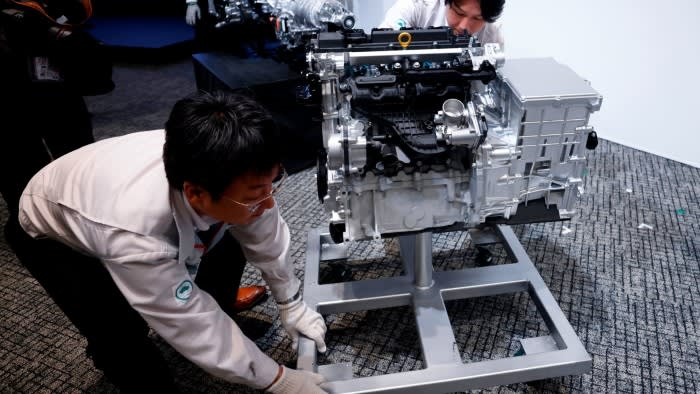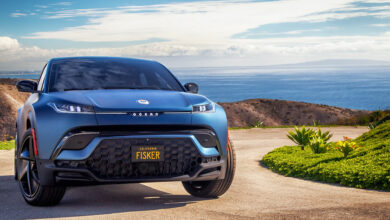Toyota makes big bet on small engines in new hybrid era

At the start of the year, as Chinese carmakers drove battery-powered vehicles forward at an ever greater pace, the chair of Toyota was telling his executives, suppliers and engineers to go out and produce better internal combustion engines.
“We will keep the fire of the engine going,” Akio Toyoda said at an event in January, using his racing name Morizo. “I will never let all the work you’ve all done so far go to waste.”
Toyota has since developed a new generation of smaller engines with a unique design using shorter pistons that promises higher fuel efficiency when used alongside batteries in hybrid vehicles. The engines can run on diesel and petrol as well as carbon-neutral fuels such as hydrogen or so-called e-fuel.
The world’s largest carmaker by sales is betting that the continued investment in the profitable fuel-based technology will pay off at a time when consumers are choosing hybrids rather than fully electric vehicles due to concerns about cost and driving range.
But industry executives and analysts remain divided on whether the Japanese group is underestimating the scale of the electric transition that is increasingly being led by its Chinese rivals and whether its bullish bet on engines could become costly in the long run.
Undeterred by moves towards higher tariffs in the US and Europe, BYD and other Chinese carmakers are aggressively making inroads into new markets in south-east Asia and Latin America with their electric vehicles. BYD, which now rivals Elon Musk’s Tesla for EV dominance, is also taking on global rivals in their traditional strongholds.
On the same day that Toyota presented plans for its new engines, the Chinese carmaker unveiled a new technology for its hybrid power train, claiming record-low fuel consumption, a driving range of 2,100km and thermal efficiency — the proportion of input energy transformed to output work — of 46 per cent.
Toyota did not disclose specifics, but its new 1.5L engine is expected to roll out around 2027, with fuel efficiency improved by 12 per cent in the sedan class and a thermal efficiency higher than its previous record of about 40 per cent.
France’s Renault has also partnered with China’s Geely to develop hybrid powertrains and internal combustion engines.
“China’s electrification process is unstoppable,” Thomas Besson, head of automotive research at Kepler Cheuvreux. “That’s why it’s very dangerous for legacy automakers to look at the hybrid boom and think everything is going great.”
For now though, Toyota’s strategy appears to be working. With the scale of its business and healthy profits, it can afford to place bets in every direction, from internal combustion technology to hybrids, pure electric cars and fuel-cell vehicles.
The recent slowing of EV sales growth in the US and China has also confirmed Toyota’s argument that the electric transition will be lumpy across the world, underscoring the consumer need for a variety of car choices beyond electric vehicles.
“Some of the global OEMs [original equipment manufacturers] are already scaling down the gasoline engine development in order to better allocate their resources to electric vehicles,” said Goldman Sachs analyst Kota Yuzawa. “I can’t say that the gasoline engine is going to be a sole differentiating factor for Toyota to capture market share, but it’s one of the important factors that we should really consider.”
Hiroki Nakajima, Toyota’s chief technology officer, acknowledged that the investment in the new engines was “a magnitude smaller” than the funding it had poured into electric vehicles, since it could make use of existing plants instead of spending billions of dollars to build new ones for batteries.
But he added that cost alone was not the group’s highest priority: “Both battery EVs and internal combustion engines are important. Our corporate value and social responsibility will change not only on our economic effectiveness but how much carbon dioxide we emit.”
In Europe, Volkswagen is among the hardest hit by the EV sales slowdown after the German carmaker made an aggressive electric shift and a bold bet on the phaseout of combustion engines. Smaller players such as Nissan have also said they would not invest more money into developing new combustion engine powertrains.
But Toyota, and others such as Stellantis and Ford, are trying to preserve highly profitable hybrid sales for as long as possible. Although it varies across the sector, analysts estimate that margins for hybrids and plug-in hybrids run from close to 10 per cent to as high as 15 per cent.
The picture for battery electric vehicles — bar outliers such as Tesla and BYD — is much grimmer, with many companies struggling to break even, let alone show profits, unless they rely on government support.
For now, Stellantis, which owns the Peugeot, Citroën, Fiat and Jeep brands, plans to sell electric vehicles for higher-end consumers, while bigger sales and profits are expected from “mild hybrids” — cars which rely on the traditional combustion engine for powering the vehicle but also use the battery to boost performance.
“Mild hybrid technology is affordable for the middle classes, the technology represents a very big volume and that technology is very, very profitable,” Carlos Tavares, the chief executive of Stellantis, said at a recent Bernstein conference in New York. He estimated that EVs were 40 to 50 per cent more expensive in total production cost than internal combustion engine cars and parity would not be reached for another few years.
The problem for carmakers is having to make decisions now on which technologies to invest in, even as consumer trends are changing at dramatic speed with the influx of Chinese EVs.
“The lead time for development in this industry is very long, and one of the big challenges that lots of automakers are facing today is the fact that the Chinese have managed to accelerate that process,” Besson said.
“Things are much faster to market now and the Chinese can spend virtually as much money as they want to get there.”
Additional reporting by Sarah White in Paris



